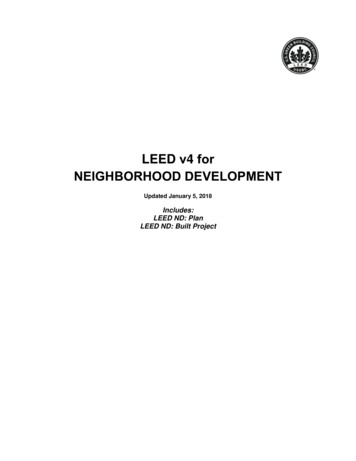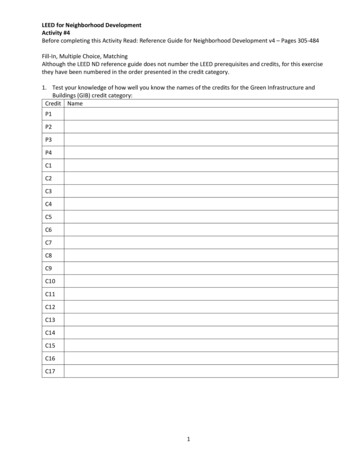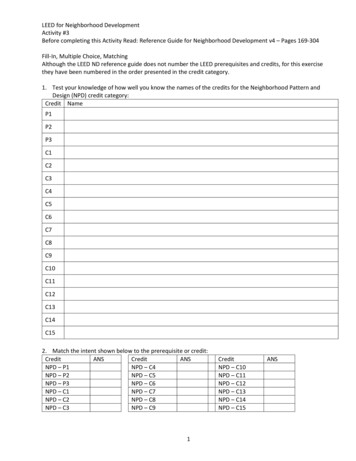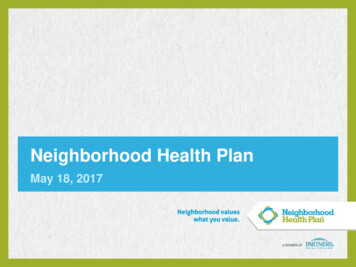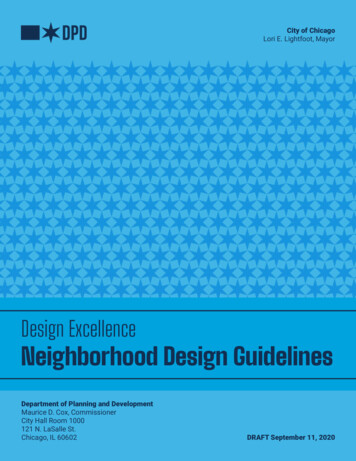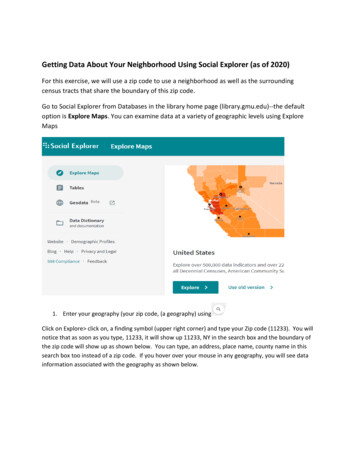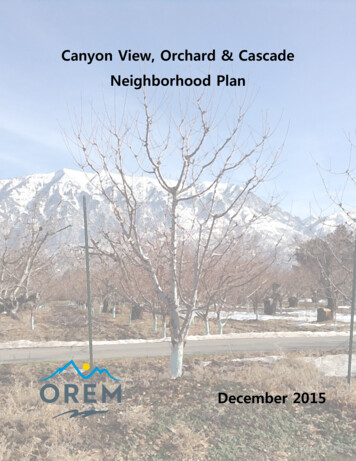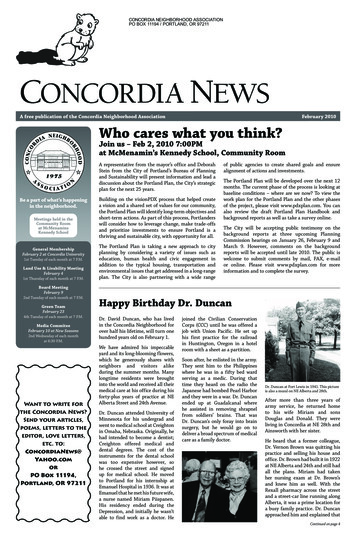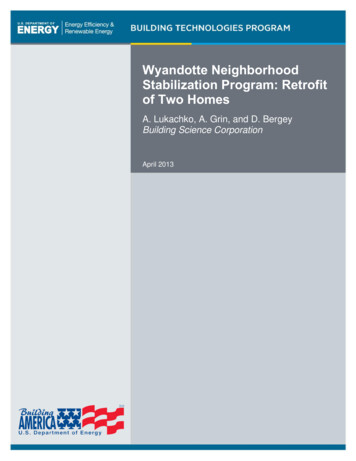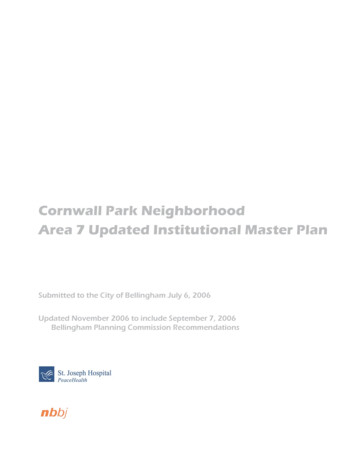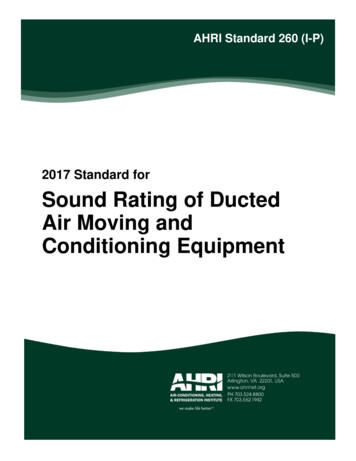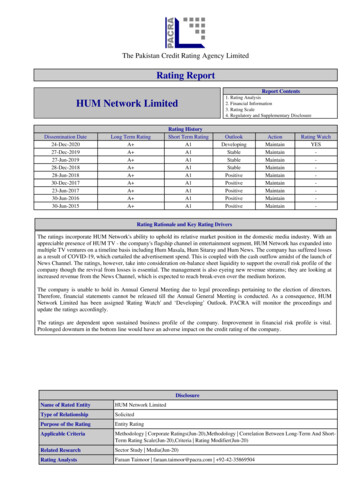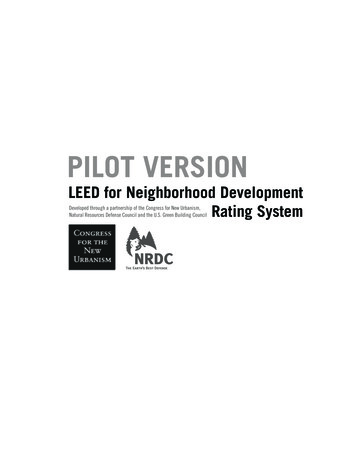
Transcription
PILOT VERSIONLEED for Neighborhood DevelopmentRating SystemDeveloped through a partnership of the Congress for New Urbanism,Natural Resources Defense Council and the U.S. Green Building CouncilCONGRESSFOR THENEWURBANISM
Disclaimer and NoticesThe U.S. Green Building Council authorizes you to view the LEED for Neighborhood DevelopmentRating System for your individual use and to copy as-is, or in part if you reference the original document.No content may be altered. In exchange for this authorization, you agree to retain all copyright and otherproprietary notices contained in the original LEED for Neighborhood Development Rating System. Youalso agree not to sell or modify the LEED for Neighborhood Development Rating System or to reproduce,display or distribute the LEED for Neighborhood Development Rating System in any way for any publicor commercial purpose, including display on a website or in a networked environment. Unauthorized useof the LEED for Neighborhood Development Rating System violates copyright, trademark and other lawsand is prohibited. All text, graphics, layout and other elements of content contained in the LEED forNeighborhood Development Rating System are owned by the U.S. Green Building Council and areprotected by copyright under both United States and foreign laws.Also, please note that none of the parties involved in the funding or creation of the LEED forNeighborhood Development Rating System, including the U.S. Green Building Council or its members,make any warranty (express or implied) or assume any liability or responsibility, to you or any thirdparties for the accuracy, completeness, or use of, or reliance on, any information contained in the LEEDor Neighborhood Development Rating System, or for any injuries, losses or damages (including, withoutlimitation, equitable relief) arising out of such use or reliance. As a condition of use, you covenant not tosue, and agree to waive and release the U.S. Green Building Council and its members from any and allclaims, demands and causes of action for any injuries, losses or damages (including, without limitation,equitable relief) that you may now or hereafter have a right to assert against such parties as a result ofyour use of, or reliance on, the LEED for Neighborhood Development Rating System.CopyrightCopyright 2007 by the U.S. Green Building Council. All rights reserved.TrademarkLEED is a registered trademark of the U.S. Green Building Council.Minor changes, including only corrected typos and minor clarifications, have been made tothis version that were not included in the February 2007 version of the LEED forNeighborhood Development rating system. In addition, an alternative version of GCTCredit 9 (Stomwater Management) is provided with this version. Prerequisite and creditrequirements were not changed in any way that would affect a project’s ability to achievethem.
Table of ContentsINTRODUCTION . 1PROJECT CHECKLIST . 4SMART LOCATION & LINKAGE . 6SLL Prerequisite 1: Smart Location.6SLL Prerequisite 2: Proximity to Water and Wastewater Infrastructure .9SLL Prerequisite 3: Imperiled Species and Ecological Communities. 11SLL Prerequisite 4: Wetland and Water Body Conservation . 14SLL Prerequisite 5: Agricultural Land Conservation . 17SLL Prerequisite 6: Floodplain Avoidance . 20SLL Credit 1: Brownfields Redevelopment . 23SLL Credit 2: High Priority Brownfields Redevelopment . 25SLL Credit 3: Preferred Locations . 27SLL Credit 4: Reduced Automobile Dependence . 29SLL Credit 5: Bicycle Network . 32SLL Credit 6: Housing and Jobs Proximity . 34SLL Credit 7: School Proximity . 36SLL Credit 8: Steep Slope Protection . 38SLL Credit 9: Site Design for Habitat or Wetland Conservation . 41SLL Credit 10: Restoration of Habitat or Wetlands . 44SLL Credit 11: Conservation Management of Habitat or Wetlands . 46NEIGHBORHOOD PATTERN & DESIGN .48NPD Prerequisite 1: Open Community . 48NPD Prerequisite 2: Compact Development. 50NPD Credit 1: Compact Development . 52NPD Credit 2: Diversity of Uses . 54Pilot Version: LEED for Neighborhood Development Rating SystemUpdated June 2007
NPD Credit 3: Diversity of Housing Types . 56NPD Credit 4: Affordable Rental Housing. 59NPD Credit 5: Affordable For-Sale Housing . 61NPD Credit 6: Reduced Parking Footprint . 63NPD Credit 7: Walkable Streets . 65NPD Credit 8: Street Network . 69NPD Credit 9: Transit Facilities . 71NPD Credit 10: Transportation Demand Management . 73NPD Credit 11: Access to Surrounding Vicinity. 76NPD Credit 12: Access to Public Spaces . 78NPD Credit 13: Access to Active Spaces . 80NPD Credit 14: Universal Accessibility . 83NPD Credit 15: Community Outreach and Involvement . 86NPD Credit 16: Local Food Production . 89GREEN CONSTRUCTION & TECHNOLOGY .92GCT Prerequisite 1: Construction Activity Pollution Prevention. 92GCT Credit 1: LEED Certified Green Buildings . 94GCT Credit 2: Energy Efficiency in Buildings. 96GCT Credit 3: Reduced Water Use.101GCT Credit 4: Building Reuse and Adaptive Reuse .104GCT Credit 5: Reuse of Historic Buildings .106GCT Credit 6: Minimize Site Disturbance through Site Design .108GCT Credit 7: Minimize Site Disturbance during Construction .110GCT Credit 8: Contaminant Reduction in Brownfields Remediation .113GCT Credit 9: Stormwater Management .115GCT Credit 10: Heat Island Reduction .118GCT Credit 11: Solar Orientation .121GCT Credit 12: On-Site Energy Generation.123Pilot Version: LEED for Neighborhood Development Rating SystemUpdated June 2007
GCT Credit 13: On-Site Renewable Energy Sources.126GCT Credit 14: District Heating & Cooling .129GCT Credit 15: Infrastructure Energy Efficiency .131GCT Credit 16: Wastewater Management .133GCT Credit 17: Recycled Content in Infrastructure.135GCT Credit 18: Construction Waste Management .137GCT Credit 19: Comprehensive Waste Management .139GCT Credit 20: Light Pollution Reduction .141INNOVATION & DESIGN PROCESS . 144ID Credit 1: Innovation and Exemplary Performance .144ID Credit 2: LEED Accredited Professional .146DEFINITIONS . 148APPENDIX A: List of Diverse Uses . 152APPENDIX B: GCT Credit 9: Stormwater Management (February 2007 version) . 153Pilot Version: LEED for Neighborhood Development Rating SystemUpdated June 2007
Pilot Version: LEED for Neighborhood Development Rating SystemUpdated June 2007
IntroductionOverviewThe U.S. Green Building Council (USGBC), the Congress for the New Urbanism (CNU), and the NaturalResources Defense Council (NRDC)—three organizations that represent some of the nation’s leadersamong progressive design professionals, builders, developers, and the environmental community—havecome together to develop a national set of standards for neighborhood location and design based on thecombined principles of smart growth, new urbanism, and green building. The goal of this partnership isto establish these standards for assessing and rewarding environmentally superior development practiceswithin the rating framework of the LEED (Leadership in Energy and Environmental Design) GreenBuilding Rating System .Unlike other LEED products that focus primarily on green building practices, with relatively few creditsregarding site selection and design, LEED for Neighborhood Development places emphasis on the designand construction elements that bring buildings together into a neighborhood, and relate the neighborhoodto its larger region and landscape. The work of the committee is guided by sources such as the SmartGrowth Network’s ten principles of smart growth, the Charter of the New Urbanism, and other LEEDrating systems. LEED for Neighborhood Development creates a label, as well as guidelines for designand decision-making, to serve as an incentive for better location, design, and construction of newresidential, commercial, and mixed use developments.The existing LEED for New Construction Rating System has a proven track record of encouragingbuilders to utilize green building practices, such as increasing energy and water efficiency and improvingindoor air quality in buildings. It is the hope of the partnership that LEED for NeighborhoodDevelopment will have a similarly positive effect in encouraging developers to revitalize existing urbanareas, reduce land consumption, reduce automobile dependence, promote pedestrian activity, improve airquality, decrease polluted stormwater runoff, and build more livable, sustainable, communities for peopleof all income levels.How LEED Rating Systems WorkLEED provides rating systems that are voluntary, consensus-based, market-driven, grounded in acceptedenergy and environmental principles, and that strike a balance between established practices andemerging concepts. LEED rating systems are developed by committees, in adherence with USGBCpolicies and procedures guiding the development and maintenance of rating systems. LEED forNeighborhood Development is one of a growing portfolio of rating systems serving specific marketsectors.LEED rating systems typically consist of a few prerequisites and many credits. In order to be certified, aproject must meet each prerequisite. Each credit is optional, but achievement of each credit contributes tothe project’s point total. A minimum point total is required for certification, and higher point scores arerequired for silver, gold, or platinum LEED certification.What is a “Neighborhood Development”?The rating system is designed to certify exemplary development projects that perform well in terms ofsmart growth, new urbanism, and green building. Projects may constitute whole neighborhoods, fractionsof neighborhoods, or multiple neighborhoods. Smaller, infill projects that are single use but complementPilot Version: LEED for Neighborhood Development Rating SystemUpdated June 20071
existing neighboring uses should be able to earn certification as well as larger and mixed usedevelopments.The LEED for Neighborhood Development Pilot ProgramUp to 120 projects in total will be selected to be a part of the pilot program. The objective of the pilotprogram is to ensure that the rating system is practical for application and is an effective to
LEED for Neighborhood Development Rating System . Disclaimer and Notices The U.S. Green Building Council authorizes you to view the LEED for Neighborhood Development Rating System for your individual use and to copy as-is, or in part if you reference the original document. No content may be altered. In exchange for this authorization, you agree to retain all copyright and other proprietary .
